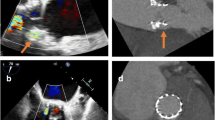Abstract
Transcatheter closure of paravalvular leaks requires precise assessment of the location, size, and shape of the defect. Transesophageal echocardiography plays an important role in this process. We encountered a case of a paravalvular leak at the aortic position after aortic and mitral valve replacement. It was impossible to detect the precise location of the paravalvular leak with transesophageal echocardiography because of an acoustic shadow from the mitral mechanical valve. Intraoperative use of intravascular ultrasound was useful for determining the morphology of the defect and evaluating the procedure during the operation.


Similar content being viewed by others
References
Hara H, Matsumoto Y, Matsumoto T, Kar S, Hashimoto G, Araki T, et al. Percutaneous antegrade mitral paravalvular leak closure through porcelain atrial septum—first percutaneous paravalvular leak closure in Japan. Circ J. 2015;79:894–6.
Rihal CS, Sorajja P, Booker JD, Hagler DJ, Cabalka AK. Principles of percutaneous paravalvular leak closure. JACC Cardiovasc Interv. 2012;5:121–30.
Murakami T, Suehiro Y, Nishimura S, Sugioka K, Iwata S, Ito A, et al. Transcatheter closure through transapical access for mitral paravalvular leak after previous trans-septal mitral operation. Gen Thorac Cardiovasc Surg. 2016. doi:10.1007/s11748-016-0644-1 (Epub ahead of print).
Sorajja P, Cabalka AK, Hagler DJ, Rihal CS. The learning curve in percutaneous repair of paravalvular prosthetic regurgitation. J Am Coll Cardiol Interv. 2014;7:521–9.
Yildirim A, Goktekin O, Gorgulu S, Norgaz T, Akkaya E, Aydin U, et al. A new specific device in transcatheter prosthetic paravalvular leak closure: a prospective two-center trial. Catheter Cardiovasc Interv. 2016. doi:10.1002/ccd.26439 (Epub ahead of print).
Author information
Authors and Affiliations
Corresponding author
Ethics declarations
Conflict of interest
Takashi Murakami, Hiromichi Fujii, Masanori Sakaguchi, Yosuke Takahashi, Yasuo Suehiro, Shinsuke Nishimura, Yoshito Sakon, Daisuke Yasumizu, Etsuji Sohgawa, and Toshihiko Shibata have no conflicts of interest.
Rights and permissions
About this article
Cite this article
Murakami, T., Fujii, H., Sakaguchi, M. et al. Intravascular ultrasound for transcatheter paravalvular leak closure. Gen Thorac Cardiovasc Surg 65, 466–469 (2017). https://doi.org/10.1007/s11748-016-0700-x
Received:
Accepted:
Published:
Issue Date:
DOI: https://doi.org/10.1007/s11748-016-0700-x



